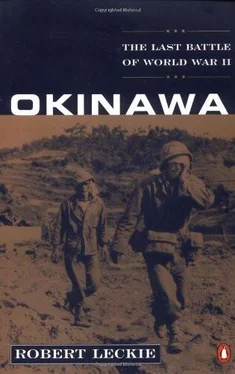Abele was on Picket Station 14 about thirty miles west of Okinawa when it was jumped by a pair of suicide Vals. Abele’s AA opened up, each burst seemingly scoring a hit but with the planes reappearing through the smoke. One of the attackers was sent into the sea, but the second struck the destroyer’s after engine room, spreading death and destruction and causing Abele to buckle visibly. Just then one of two Betty bombers circling like scavengers overhead released its baka bomb, which came shrieking at the stricken destroyer at five hundred knots. The pilot kept his missile perfectly on course, striking Abele exactly amidships. A tremendous blast lifted the American out of the water to be slammed back again. Many men were blown overboard, among them Lieutenant s.g. George Wray, who swam back to his ship, clambering aboard to tear open a jammed escape hatch allowing the entire watch of the forward engine room to scramble to safety. In less than another minute, Wray might have been too late, for Abele sank five minutes after the baka struck. Most of her officers and crew were rescued by a nearby LSM, but six men were killed and seventy-three missing.
Simultaneous with the agony of Abele, a flight of conventional kamikaze found Rear Admiral Deyo’s gunfire support force patrolling waters off the Motobu Peninsula. When they struck, Deyo fortunately had his ships concentrated and they were ready for the Divine Winds, which could do little more than stagger a destroyer and crash a 40 mm mount aboard battleship Tennessee. One sailor who was blown into the air landed atop a five-inch gun turret, where he crouched while calmly stripping off his burning clothing to await a cold bath from the nearest fire hose. Marine Corporal W. H. Putnam either fell or was blown overboard, surfacing near a big life raft. He clambered aboard, finding unusual company in the presence of the headless torso of the kamikaze who had crashed his ship.
Thus the scourging of the American fleet off Okinawa continued unabated, but once again the kamikaze had failed to strike the paralyzing blow so eagerly sought by Admiral Ugaki. Losses among the suiciders are not exactly known, although 185 of them had participated in the assault—an enormous decline from the 355 making the first attacks. The decrease would continue until on June 21-22 Ugaki could scrape together only 45 decrepit Divine Winds—the shriveled petals remaining on the deadly Floating Chrysanthemums.
Uncle Sam: Logistics Magician
CHAPTER FOURTEEN
Triumphs of logistics, though impressive, usually do not make “rattling good reading,” as one British historian wrote of the Napoleonic Wars. Yet the industrial and logistics feat of the United States of America fighting the first great two-ocean war on record is unrivaled in the history of humankind; and at Okinawa during the culminating battle of the Island War, as well as the greatest amphibious operation in military annals, the Americans had to overcome two unprecedented challenges.
First, it had to supply this unrivaled sea invasion at a distance of seventy-five hundred miles from its western shores. Second, it had to keep a fleet unsurpassed in numbers of ships and firepower constantly at sea for weeks at a time while feeding it with ammunition, food, fuel, airplanes, and those myriad lesser demands of an invader engaged on land and sea and in the air.
Even more than Admiral Spruance’s Fifth Fleet and Mitscher’s Task Force Fifty-eight, General Buckner’s Tenth Army was a monster of consumption. Between April 1 and 16 alone, no less than 577,000 tons of supplies were landed on the Hagushi Beaches, a record achieved in the face of two destructive storms and the attacks of the kamikaze. A difficulty unsuspected by the Iceberg planners—though actually a happy one—was the incredible speed of the advance of Buckner’s attacking divisions, so rapid that Ducks and amphibious tractors expecting to haul their supplies no farther than the beaches were obliged to roll far inland to unload.
Another problem caused by unforeseen success was that because planners had placed the unloading priority of spare vehicles lower than such vital supplies as ammunition, barbed wire, fuel, and food, these first-priority supplies had to be heaped on the beaches to get at the now-sorely-needed jeeps and trucks. This caused the breakdown of an elaborate plan for supply dumps to be established at carefully selected points. Night unloading under floodlights, suspended only during air-raid alerts, helped to unload waiting ships speedily, but also added to beach congestion.
On April 13 General Buckner was dismayed to learn that during the past twenty-four hours only 640 tons of artillery ammunition had crossed the beaches, not nearly enough to supply guns expending more shells than planners had anticipated. Buckner immediately gave priority to artillery shells, and in the next few days 3,000 tons daily were deposited ashore—enough not only for those tireless guns but also to begin building a reserve.
Okinawa’s “excellent network of bad roads”—all narrow and lightly surfaced—could not be traversed by American armored tractors and six-by-six trucks. Those early April rainstorms that had delayed unloading of ships also made the roads softer, compelling American engineers to try to harden them with sand mixed with coral. But the coral was not easy to dig and had to be blasted frequently. Without a rock crusher, the engineers sometimes dumped coral fragments as big as boulders on the roads, turning some of them into obstacle courses.
Erection of numerous pontoon causeways from the reefs to solid ground helped ease the continuing problem of moving supplies from ship to shore. LCTs—Landing Craft, Tank—and LSMs could tie up to the small ones, transferring their cargo directly into trucks. The bigger ships at the bigger causeways used cranes. Red Beach 1 opposite Yontan Airfield had the largest causeway: 1,428 feet long with a pierhead 45 by 175 feet. During the first few days sixty thousand men and 110,000 tons of cargo crossed the piers.
The most serious shortage was in shells for the 81 mm mortars—those unlovely “stovepipes” that probably have killed more soldiers than any other weapon devised—caused by the loss to kamikaze April 6 of those two ammunition ships. But the ever-resourceful Admiral Turner quickly put in an emergency request to Guam, and 117 tons of mortar shells were airlifted to Okinawa, enough to keep the stovepipes firing until many more tons could arrive by ship. Yontan and Kadena Airfields were kept so well supplied that not a single plane was grounded for lack of fuel during the entire campaign.
Fifth Fleet and TF 58 were supplied by a force of cargo ships and oilers commanded by Rear Admiral D. G. Beary from his flagship in the old light cruiser Detroit. When Beary received requests from carrier groups for oil and/or ammunition, he would send formations of the necessary ships hurrying to the flattop fleets to begin replenishment at dawn and complete it by dusk. Long before Okinawa, the Navy had perfected the system of refueling at sea, and eventually replacement ships were trained to fill the carriers’ every need—even such bulky items as crated airplane engines or jeeps for use on flight decks. Weapons, bombs, and bullets were soon added, and thus at Okinawa TF 58 could remain almost indefinitely at sea—a fact that might be a boon to Admiral Mitscher, but a bore to his “swab-jockeys” weary of sea duty and eager for a little fun ashore. In the immemorial rhythm of “for want of a nail a shoe was lost,” the most serious problem was inadequate supplies of 3½- and 4-inch Manila line, and this would not be solved until the Philippines were completely reconquered.
Читать дальше










